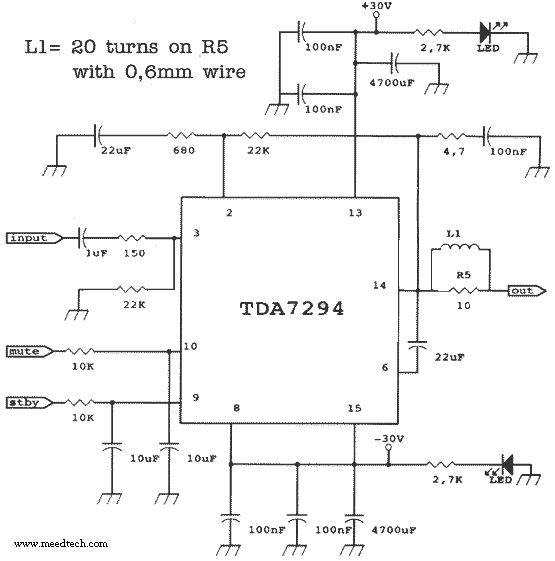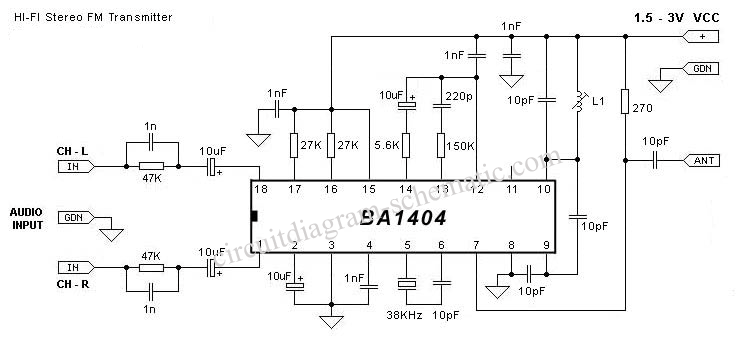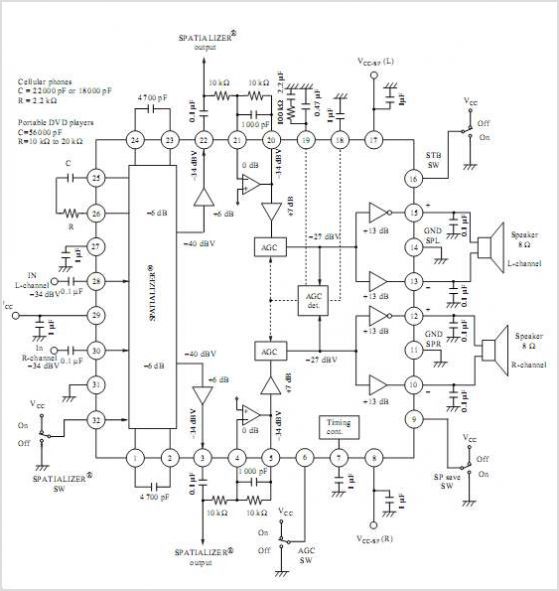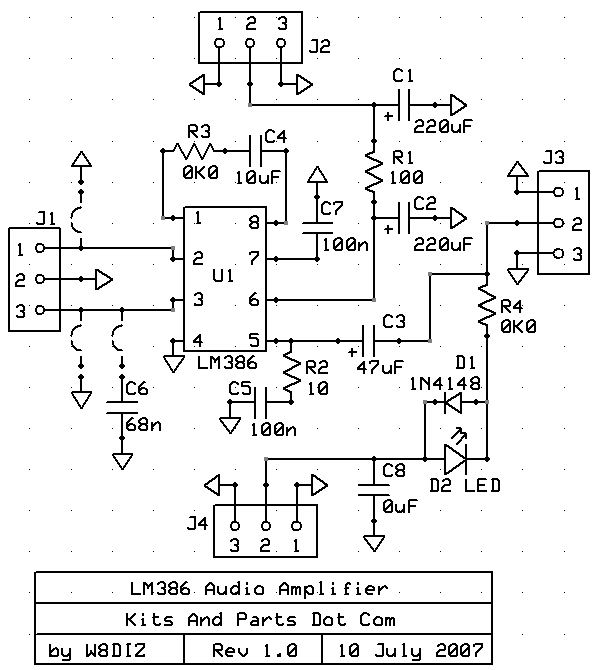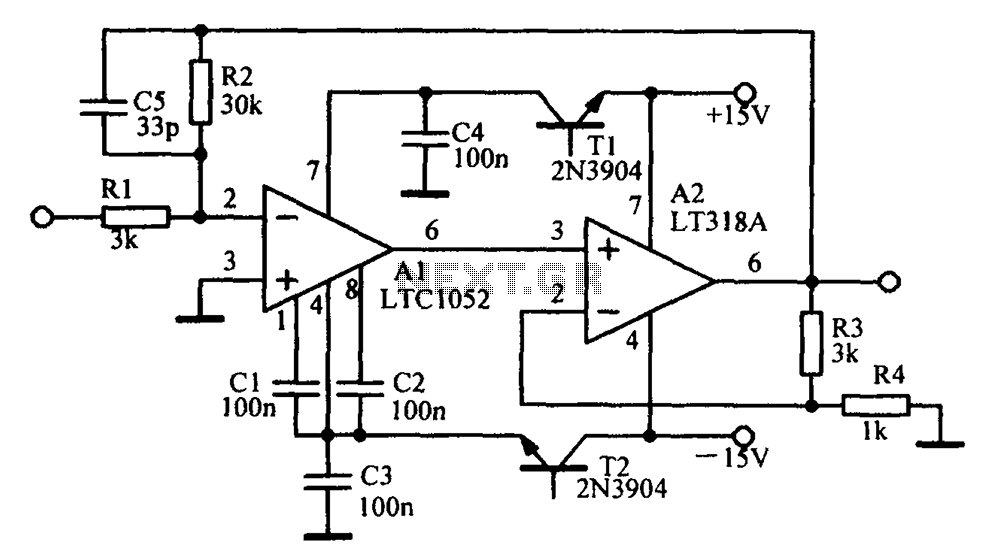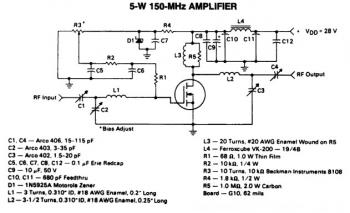
Stereo OTL Audio Amplifier
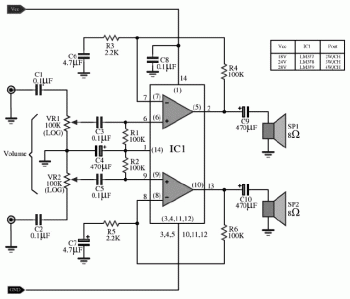
The following diagram illustrates the circuit of a Stereo OTL Audio Amplifier. It is based on an integrated circuit (IC), making the circuit design straightforward. The amplifier project can utilize ICs such as LM379, LM377, or LM378. According to the specifications, the maximum voltage supply for the LM379 is 28V, which can deliver 4W per channel. The LM377 has a maximum Vcc voltage of 18V for single supply operation, providing approximately 2W per channel. In contrast, the LM378 operates with a maximum regulated DC power supply of 24V, yielding 3W of high-fidelity audio power per channel. An audio amplifier is an electronic device that amplifies low-power audio signals, which are primarily composed of frequencies ranging from 20 Hz to 20,000 Hz, the human hearing range. This amplification makes the signals suitable for driving loudspeakers and represents the final stage in a typical audio playback chain. Preceding stages in this chain include low-power audio amplifiers that perform functions such as pre-amplification, equalization, tone control, and mixing effects, originating from audio sources like record players, CD players, and cassette players. Most audio amplifiers require these low-level inputs to conform to line levels. While the input signal to an audio amplifier may measure only a few hundred microwatts, its output can range from tens to thousands of watts. Additional information about power audio amplifiers can be found on Wikipedia. A video tutorial is available that demonstrates how to build a very simple audio amplifier based on the LM386 amplifier chip, which can be constructed for less than $20 (or even under $8 in some regions) and can amplify any low-level audio signal, including those from a guitar, bass, or MP3 player.
The Stereo OTL Audio Amplifier circuit utilizes integrated circuits to simplify the design and implementation process. The choice of ICs—LM379, LM377, and LM378—provides flexibility in terms of power output and supply voltage, allowing users to select the appropriate component based on their specific requirements.
The LM379, with a maximum supply voltage of 28V, offers the highest power output of 4W per channel, making it suitable for applications requiring robust sound amplification. The LM377, while limited to a maximum of 18V, still provides a respectable output of 2W per channel, ideal for smaller audio setups. The LM378, operating at a maximum of 24V, delivers 3W per channel, striking a balance between power and voltage supply.
In audio amplification systems, the role of the amplifier is crucial. It takes low-power audio signals, often originating from various audio sources, and boosts them to a level that can effectively drive loudspeakers. This process is essential in ensuring that sound reproduction is clear and powerful, enhancing the overall listening experience. The circuit design typically includes various stages, with the audio amplifier being the final stage, ensuring that the output is suitable for playback on loudspeakers.
The circuit can be further enhanced by integrating additional components such as capacitors for filtering and resistors for setting gain levels. Proper layout and grounding techniques are essential to minimize noise and interference, ensuring high-quality audio output. The simplicity of the design allows for easy troubleshooting and modifications, making it an excellent project for both beginners and experienced electronics enthusiasts.
For those interested in practical applications, the video tutorial on building a simple audio amplifier with the LM386 chip serves as a valuable resource, demonstrating the feasibility of constructing an effective audio amplification solution at a low cost. This project exemplifies the principles of audio amplification and provides insights into the design considerations necessary for achieving high-fidelity sound reproduction.The following diagram is the circuit of Stereo OTL Audio Amplifier. It based on IC circuit, so the circuit looks simple. You can use IC LM379, LM377, LM378 for this amplifier project. Refer to the table, maximum voltage supply for IC LM379 is 28V, it will will deliver 4W/channel. For LM377, maximum Vcc voltage is 18V single supply and delivers about 2W/channel. While for LM378, use maximum 24V regulated DC power supply and you will get 3W hifi audio power per channel. An audio amplifier is an electronic amplifier that amplifies low-power audio signals (signals composed primarily of frequencies between 20 - 20 000 Hz, the human range of hearing) to a level suitable for driving loudspeakers and is the final stage in a typical audio playback chain.
The preceding stages in such a chain are low power audio amplifiers which perform tasks like pre-amplification, equalization, tone control, mixing/effects, or audio sources like record players, CD players, and cassette players. Most audio amplifiers require these low-level inputs to adhere to line levels. While the input signal to an audio amplifier may measure only a few hundred microwatts, its output may be tens, hundreds, or thousands of watts.
More explanation about power audio amplifier can be found at wikipedia. org This is a video tutorial about how to a very simple audio amplifier based on the LM386 amplifier chip. It can be built for less than $20 (or might be less than $8 in some countries) and used to amplify any low level audio signal including a guitar, bass or mp3 player.
🔗 External reference
The Stereo OTL Audio Amplifier circuit utilizes integrated circuits to simplify the design and implementation process. The choice of ICs—LM379, LM377, and LM378—provides flexibility in terms of power output and supply voltage, allowing users to select the appropriate component based on their specific requirements.
The LM379, with a maximum supply voltage of 28V, offers the highest power output of 4W per channel, making it suitable for applications requiring robust sound amplification. The LM377, while limited to a maximum of 18V, still provides a respectable output of 2W per channel, ideal for smaller audio setups. The LM378, operating at a maximum of 24V, delivers 3W per channel, striking a balance between power and voltage supply.
In audio amplification systems, the role of the amplifier is crucial. It takes low-power audio signals, often originating from various audio sources, and boosts them to a level that can effectively drive loudspeakers. This process is essential in ensuring that sound reproduction is clear and powerful, enhancing the overall listening experience. The circuit design typically includes various stages, with the audio amplifier being the final stage, ensuring that the output is suitable for playback on loudspeakers.
The circuit can be further enhanced by integrating additional components such as capacitors for filtering and resistors for setting gain levels. Proper layout and grounding techniques are essential to minimize noise and interference, ensuring high-quality audio output. The simplicity of the design allows for easy troubleshooting and modifications, making it an excellent project for both beginners and experienced electronics enthusiasts.
For those interested in practical applications, the video tutorial on building a simple audio amplifier with the LM386 chip serves as a valuable resource, demonstrating the feasibility of constructing an effective audio amplification solution at a low cost. This project exemplifies the principles of audio amplification and provides insights into the design considerations necessary for achieving high-fidelity sound reproduction.The following diagram is the circuit of Stereo OTL Audio Amplifier. It based on IC circuit, so the circuit looks simple. You can use IC LM379, LM377, LM378 for this amplifier project. Refer to the table, maximum voltage supply for IC LM379 is 28V, it will will deliver 4W/channel. For LM377, maximum Vcc voltage is 18V single supply and delivers about 2W/channel. While for LM378, use maximum 24V regulated DC power supply and you will get 3W hifi audio power per channel. An audio amplifier is an electronic amplifier that amplifies low-power audio signals (signals composed primarily of frequencies between 20 - 20 000 Hz, the human range of hearing) to a level suitable for driving loudspeakers and is the final stage in a typical audio playback chain.
The preceding stages in such a chain are low power audio amplifiers which perform tasks like pre-amplification, equalization, tone control, mixing/effects, or audio sources like record players, CD players, and cassette players. Most audio amplifiers require these low-level inputs to adhere to line levels. While the input signal to an audio amplifier may measure only a few hundred microwatts, its output may be tens, hundreds, or thousands of watts.
More explanation about power audio amplifier can be found at wikipedia. org This is a video tutorial about how to a very simple audio amplifier based on the LM386 amplifier chip. It can be built for less than $20 (or might be less than $8 in some countries) and used to amplify any low level audio signal including a guitar, bass or mp3 player.
🔗 External reference
Warning: include(partials/cookie-banner.php): Failed to open stream: Permission denied in /var/www/html/nextgr/view-circuit.php on line 713
Warning: include(): Failed opening 'partials/cookie-banner.php' for inclusion (include_path='.:/usr/share/php') in /var/www/html/nextgr/view-circuit.php on line 713
